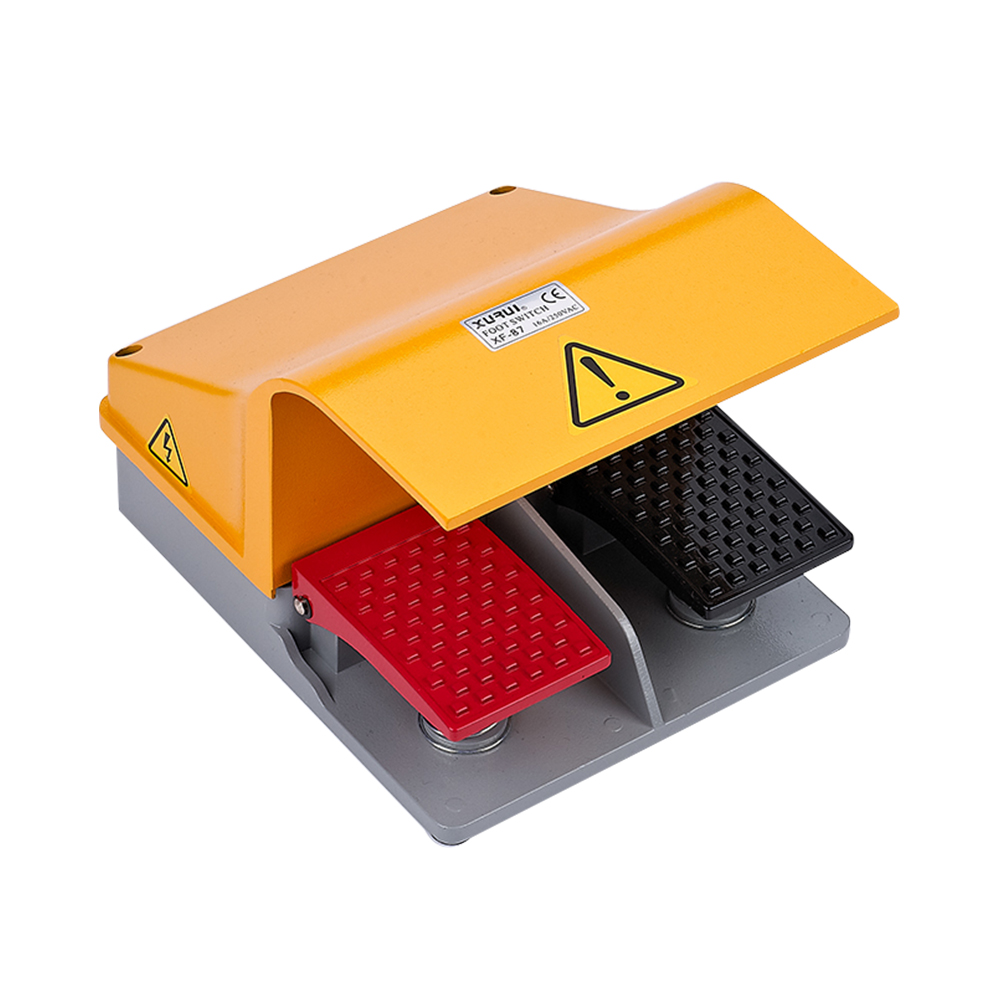脚控开关是用来做什么的?
脚踏开关提供对机器、工具和软件的免提控制,提高各种工作环境中的速度、安全性和舒适度。 无论是在工厂、诊所还是音乐工作室,这些设备都能提高效率。 本指南将解释什么是脚踏开关、它们的工作原理以及它们在当今工作场所的重要性。
什么是脚踏开关,它是如何工作的?
脚踏开关在许多领域都有应用,但平民往往对它们的作方式知之甚少。 它们是基本的,但对工作场所的生产力和安全有着巨大的影响。
定义和核心功能
脚踏开关是一种允许您通过将脚压在开关上来激活开关的方法。 感觉就像一个电灯开关,只是它在地板上。 主要思想是使个人能够用脚作小工具和其他设备,从而解放双手从事各种活动。 这使得工作更快、更安全、更舒适。
脚踏开关如何在不同系统中运行
当他们被迫时,他们会发出启动或退出某事的提示。 例如,工人可以使用脚踏开关为机器供电。 医生可能会用它来进行 X 光检查。 其他开关只需接线并利用各种类型的技术。
主要变体:瞬时、维护、有线、无线
脚踏开关有多种类型,其作方式也不同。 选择一种取决于要完成的工作和使用频率。
瞬时开关只有在您按下时才能运行。 维护的开关始终在按下时保持打开状态,在按下另一次按下时始终保持关闭状态。 电线开关是有线的。 无线开关通过空中传输。 需求因每种类型的工作而异。
脚踏开关与其他开关机制
脚踏开关让您解放双手,这与手动开关或按钮不同。 您无需停止作即可打开开关。 这使它们有资格在速度和安全至关重要的领域发挥最佳作用。 脚踏开关还可以降低因分心或延误而发生事故的风险。

脚踏开关有什么用?
脚踏开关在现代工业中有多种用途。 它们因其易用性和提供的额外控制级别而受到重视。
免提控制,提高效率和生产力
脚踏开关的存在使工作更轻松、更快捷。 脚踏开关将使您能够使用机器,而无需在双手被占用时停下来。 这意味着您可以在更短的时间内做更多的事情。 它是用于装配线、车间和办公室的优秀产品。
工业和医疗环境中的安全性增强
在高风险的工作中,安全是第一位的。 脚踏开关可帮助员工避免将手放在有活动部件的区域。 它们使医生和护士能够在不接触设备的情况下使用设备,从而降低医疗实践中暴露的风险,并使他们能够保持对患者的注意力。
敏感工作空间的无菌和卫生优势
洁净室和医院的卫生很重要。 脚踏开关最大限度地减少了手与工具的接触。 这可以防止细菌并满足健康法规。 它们存在于实验室、诊所空间和食品加工设施中,通常是为了确保严格的清洁度。
人体工程学优势和身体缓解
手工工作会导致疼痛或受伤。 脚踏开关将使您能够用脚移动。 这可以减轻您的双手负担。 随着时间的推移,它们可以帮助工人感觉更好,并预防手腕疼痛等慢性问题。
谁需要脚踏开关? 主要用户群体
不同的专业人士以独特的方式从脚踏开关中受益。 从工业用途到创意领域,脚踏开关都是适应性很强的工具。
工业和医疗专业人员
工厂工人、外科医生和实验室工作人员都受益于脚踏开关。 这些用户需要速度和安全。 脚踏开关让他们保持控制,同时专注于最重要的事情——他们的任务或患者。
创意和技术用户
音乐家在演奏时使用脚踏板来控制音效。 视频编辑器免提启动或停止素材。 平面设计师在数字软件中使用脚踏开关作为工具。 这些用户需要在不中断其创意流程的情况下进行流畅控制。
办公室人员和注重辅助功能的用户
上班族可以使用脚踏开关作软件、接听电话或用手听写。 它们也适合行动不便的人。 使用脚踏开关作计算机可能更容易、更舒适。
跨行业的实际应用
脚踏开关存在于各种工作场所。 它们适用于小型办公室和大型工厂。
工厂的自动化和机器控制
切割机、压力机或传送带使用脚踏开关。 它们可以保护工人并促进更快的生产。 工人可以通过踩下脚踏板而不是手柄或按钮来引导材料。
医疗设备作中的脚踏板
脚踏开关用于 X 射线设备、手术刀和牙科设备。 这些踏板使他们能够保持双手无菌并迅速做出反应。 这意味着患者更安全、更快捷。
音乐和数字制作中的创意用途
吉他手使用脚部效果。 录音室工程师使用它们来打开和关闭录音。 PODcasters 甚至可以使用脚踏开关来静音或提示声音。 它保持无缝且免提的工作流程。
实现可访问性和工作流程优化
脚踏开关可以帮助残障用户更轻松地浏览数字系统。它们还通过更换额外的按钮或遥控器来帮助减少混乱。在办公室或家庭中,它们可以改善工作流程并增加舒适度。

脚踏开关有助于解决哪些问题?
脚踏开关不仅方便,还可以解决繁忙工作环境中的实际问题。让我们看看他们帮助克服的一些最大挑战。
有限的手部可用性和多任务处理限制
当双手被占用时,有时需要打开或关闭某些东西。这可以通过脚踏开关解决,它增加了一个控制点。您可以保持专注并更有效地完成任务。
重复的工作流程、身体疲劳和受伤风险
重复做同样的动作可能会导致手或手臂疼痛。您可以使用脚踏开关改变您的动作。这增加了工作的乐趣,减少了不适或损坏的机会。
工作空间混乱、可访问性挑战和界面过载
您的工作站可能会挤满太多按钮和工具。其中一些杂乱可以通过脚踏开关消除。对于难以使用键盘或触摸屏的个人来说,这种方法也是增强可访问性的简单方法。
如何为您的企业选择合适的脚踏开关
选择合适的脚踏开关首先要了解您的环境和需求。每种类型适合不同的任务。
定义使用场景和环境需求
考虑开关的使用地点和方式。它会在潮湿或多尘的地方吗?是用于洁净室还是繁忙的地板?选择专为您的特定工作环境设计的交换机。
了解开关类型和触发机制
评估您是否需要一键式或按住开关。对于简短的任务,瞬时开关是理想的选择。已经存在很长时间的流程在维护良好的交换机上表现更好。另外,请考虑连接是有线的还是无线的。
优先考虑人体工程学、耐用性和安全等级
选择易于作的设计。查找握把底座和刚性材料。确保交换机安全。好的设计磨损时间更长,可以保护您的团队。
确保设备和软件兼容性
交换机必须与您的机器或程序配合使用。检查电压和连接类型。一些交换机还需要驱动程序或软件支持。购买前请务必匹配规格。

企业中的脚踏开关:为什么它们很重要
脚踏开关可以在商业环境中产生很大的影响。它们提高了许多行业的安全性、生产力和工作流程。
通过免提控制提高效率和投资回报率
当工人能够使用他们的脚时,他们的工作效率更高,频率更低。这增加了产量并更有效地利用了时间。随着时间的推移,脚踏开关可以帮助公司节省资金并改善结果。
增强安全合规性并减少停机时间
脚踏开关帮助团队遵守安全规则。它们还可以减少错误或事故,从而减少停机时间。这意味着更少的时间损失和更好的设备保养。
可扩展运营的定制和集成
一些脚踏开关可以针对不同的任务进行编程。它们适合大型系统或智能机器。这有助于公司在保持简单控制的同时发展。
支持包容性和面向未来的工作流程
脚踏开关可满足广泛的需求。它们使工作场所更加温馨。随着数字工具的发展,脚踏开关继续支持灵活和现代的工作方式。
结论
脚踏开关不仅仅是简单的踏板;它们是智能且安全的工具,可以提高各行业的效率。无论是在工厂、医院还是工作室,它们都有助于加快任务速度,同时提高安全性。要找到适合您需求的脚踏开关,请选择像旭瑞开关这样值得信赖的供应商,它提供了广泛的可靠选择。
通过将脚踏开关纳入您的工作流程,您可以增强安全性、提高生产力并简化流程,从本质上为您提供额外的帮助来更有效地处理任务。
